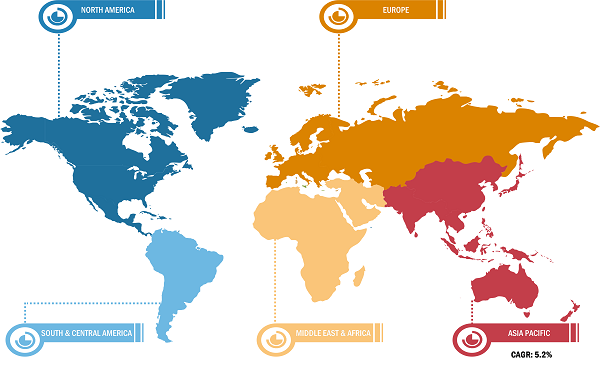Increasing Vehicle Production and Sales Drive Global Automotive Fabric Market Growth
According to the latest market study on “Automotive Fabric Market Forecast to 2030 – COVID-19 Impact and Global Analysis – by Component and Material,” the global automotive fabric market size was valued at US$ 41,513.83 million in 2022 and is projected to reach US$ 60,722.34 million by 2030; it is anticipated to record a CAGR of 4.9% from 2022 to 2030. The report highlights key factors driving the market growth and prominent players along with their developments in the market.
Automotive fabrics are extensively used for interior rims: seat covers, carpets, side panels, lining, filters, airbags, roofs, and door liners. Automotive textiles are used in various applications, such as carpets, seat belts, car interior components, and upholstery. It offers aesthetics, lightweight, durability, wear & tear resistance, and abrasion resistance. Market players produce automotive fabric complying with the specific customer requirements and technical specifications. The automotive industry adheres to stringent regulations imposed by the government and other organizations. Automotive fabric producers also adhere to upholstery standards for safety and durability set by original equipment manufacturers.
Global Automotive Fabric Market Breakdown – by Region
Automotive Fabric Market Size and Forecast (2020 - 2030), Global and Regional Share, Trend, and Growth Opportunity Analysis Report Coverage: By Component (Carpet, Headliner, Hood Liner, Insulation, Seat Covering Material, and Others) and Material (Textiles, Artificial Leather, Genuine Leather, and Artificial Suede)
Automotive Fabric Market Report | Size, Share & Growth by 2030
Download Free Sample
The utilization of automotive fabric is driven by applications in carpet, headliner, hood liner, insulation, and seat covering material. Automotive fabrics are also used in door kick panels, boot linings, and insulation materials. Carpet backing is manufactured by a spun-bonding and integrated process that involves the melting of polymer chips and filaments extraction. Automobile manufacturers favor the utilization of weft-knitted fabrics for upholstery. The advancement in automotive manufacturing capabilities and rising demand for electric vehicles are a few factors driving the global automotive industry. Automotive is one of the leading industries in Europe as it contributes significantly to the GDPs of European countries, including Germany, Italy, and the UK, among others. According to the report by the European Commission, turnover generated by the automotive industry in Europe represents 7% of the region's total GDP. A report by Germany Trade & Invest stated that Germany is a major automotive market in Europe, and it registered a foreign market revenue of US$ 289 billion in 2021 (a 10% rise from 2020) from passenger car and light commercial vehicle original equipment manufacturers. According to a report by the International Energy Agency in 2022, 2.3 million electric vehicles were sold in Europe in 2021 (a rise from 1.4 million in 2020).
Lear Corp, Bader GmbH & Co KG, BOXMARK Leather GmbH & Co KG, AUNDE Group SE, Grupo Empresarial Copo SA, Classic Soft Trim Inc, Dual Borgstena Textile Portugal Unipessoal Lda, Shawmut Corp; Apex Mills Corp, Seiren Co Ltd are among the key players in the global automotive fabric market.
Impact of COVID-19 Pandemic on Global Automotive Fabric Market Growth
During the COVID-19 pandemic, disruptions in chemical and materials manufacturing operations severely impacted global supply chains and hindered product manufacturing activities, delivery schedules, and sales. Various chemicals and materials companies reported product delivery delays and sales slump in 2020. Moreover, restrictions on international travel imposed by governments of various European and Asia Pacific countries compelled manufacturers and suppliers to temporarily discontinue their business strategies, such as partnerships. All these factors hampered many sectors during the pandemic and restrained the growth of the chemicals & materials industry. During the pandemic, supply chain disruptions, raw material and labor shortages, and operational difficulties created demand and supply gaps, adversely affecting the growth of the automotive fabric market.
In 2020, supply chain shortages, increased labor costs, and high demand for raw materials resulted in price inflation of materials required in the automotive industry across various regions. In 2021, rising vaccination rates contributed to improvements in the overall conditions in different countries, which led to a conducive environment for automobile producers, original equipment manufacturers, and aftermarkets. By the end of 2021, the sales of automotive fabric increased with the resumption of production and sales operations of companies operating in the automotive industry.
The "Global Automotive Fabric Market Analysis and Forecast to 2030" is a specialized and in-depth study of the chemicals & materials industry, focusing on the global automotive fabric market trend analysis. The report aims to provide an overview of the market with detailed market segmentation. The global automotive fabric market is divided on the basis of component and material. Based on component, the automotive fabric market is segmented into carpet, headliner, hood liner, insulation, seat covering material, and others. Based on material, the market is segmented into textiles, artificial leather, genuine leather, and artificial suede. Headliners are composed of tricot knit fabric that offers a soft touch and uniform appeal and adds to overall interior styling. Acoustic and thermal insulation is considered one of the essential features deployed across various automotive parts such as engine covers, under trays, bonnets, and other such automotive parts. With significant developments in the automotive industry, manufacturers focus on the luxury, appeal, and comfort of vehicles. Hence, the seat covering material is vital in defining the vehicle's aesthetic and providing an edge to its overall interior. The others segment of automotive fabrics includes upholstery components, seat belts, door panels, lining, tires, airbags, and hoses.
Contact Us
Phone: +1-646-491-9876
Email Id: sales@theinsightpartners.com